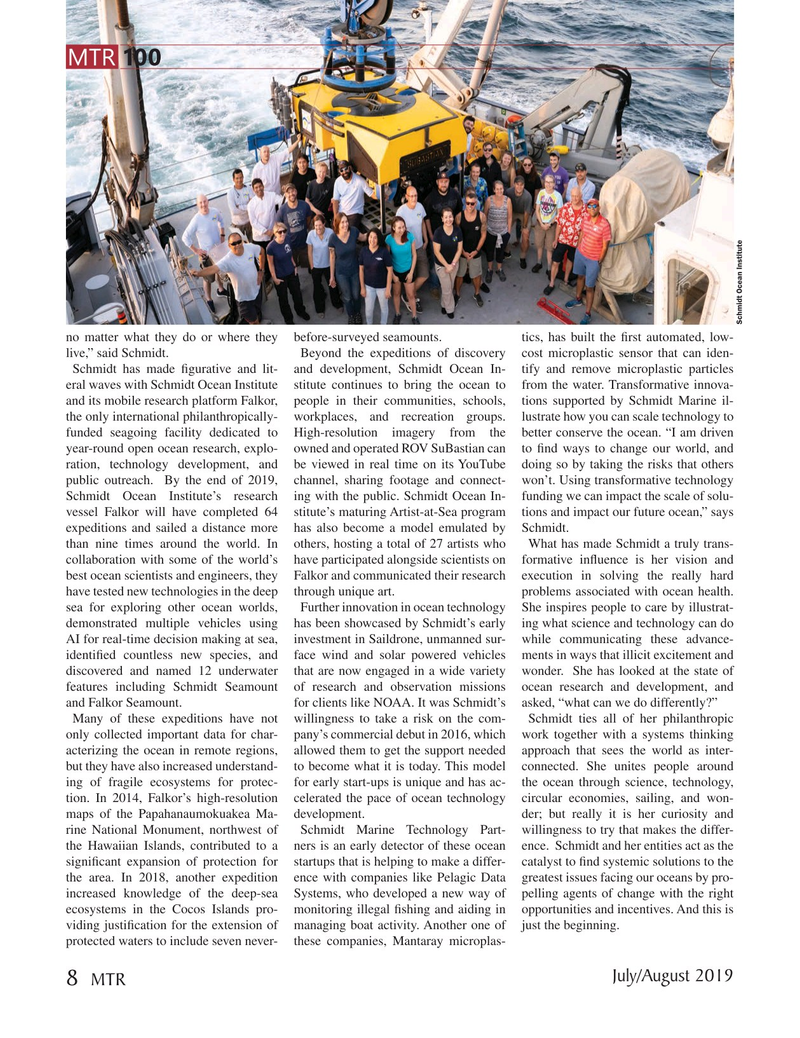
Page 8: of Marine Technology Magazine (July 2019)
MTR White Papers: Hydrographic
Read this page in Pdf, Flash or Html5 edition of July 2019 Marine Technology Magazine
MTR 100
Schmidt Ocean Institute no matter what they do or where they before-surveyed seamounts. tics, has built the ? rst automated, low- live,” said Schmidt. Beyond the expeditions of discovery cost microplastic sensor that can iden-
Schmidt has made ? gurative and lit- and development, Schmidt Ocean In- tify and remove microplastic particles eral waves with Schmidt Ocean Institute stitute continues to bring the ocean to from the water. Transformative innova- and its mobile research platform Falkor, people in their communities, schools, tions supported by Schmidt Marine il- the only international philanthropically- workplaces, and recreation groups. lustrate how you can scale technology to funded seagoing facility dedicated to High-resolution imagery from the better conserve the ocean. “I am driven year-round open ocean research, explo- owned and operated ROV SuBastian can to ? nd ways to change our world, and ration, technology development, and be viewed in real time on its YouTube doing so by taking the risks that others public outreach. By the end of 2019, channel, sharing footage and connect- won’t. Using transformative technology
Schmidt Ocean Institute’s research ing with the public. Schmidt Ocean In- funding we can impact the scale of solu- vessel Falkor will have completed 64 stitute’s maturing Artist-at-Sea program tions and impact our future ocean,” says expeditions and sailed a distance more has also become a model emulated by Schmidt. than nine times around the world. In others, hosting a total of 27 artists who What has made Schmidt a truly trans- collaboration with some of the world’s have participated alongside scientists on formative in? uence is her vision and best ocean scientists and engineers, they Falkor and communicated their research execution in solving the really hard have tested new technologies in the deep through unique art. problems associated with ocean health. sea for exploring other ocean worlds, Further innovation in ocean technology She inspires people to care by illustrat- demonstrated multiple vehicles using has been showcased by Schmidt’s early ing what science and technology can do
AI for real-time decision making at sea, investment in Saildrone, unmanned sur- while communicating these advance- identi? ed countless new species, and face wind and solar powered vehicles ments in ways that illicit excitement and discovered and named 12 underwater that are now engaged in a wide variety wonder. She has looked at the state of features including Schmidt Seamount of research and observation missions ocean research and development, and and Falkor Seamount. for clients like NOAA. It was Schmidt’s asked, “what can we do differently?”
Many of these expeditions have not willingness to take a risk on the com- Schmidt ties all of her philanthropic only collected important data for char- pany’s commercial debut in 2016, which work together with a systems thinking acterizing the ocean in remote regions, allowed them to get the support needed approach that sees the world as inter- but they have also increased understand- to become what it is today. This model connected. She unites people around ing of fragile ecosystems for protec- for early start-ups is unique and has ac- the ocean through science, technology, tion. In 2014, Falkor’s high-resolution celerated the pace of ocean technology circular economies, sailing, and won- maps of the Papahanaumokuakea Ma- development. der; but really it is her curiosity and rine National Monument, northwest of Schmidt Marine Technology Part- willingness to try that makes the differ- the Hawaiian Islands, contributed to a ners is an early detector of these ocean ence. Schmidt and her entities act as the signi? cant expansion of protection for startups that is helping to make a differ- catalyst to ? nd systemic solutions to the the area. In 2018, another expedition ence with companies like Pelagic Data greatest issues facing our oceans by pro- increased knowledge of the deep-sea Systems, who developed a new way of pelling agents of change with the right ecosystems in the Cocos Islands pro- monitoring illegal ? shing and aiding in opportunities and incentives. And this is viding justi? cation for the extension of managing boat activity. Another one of just the beginning. protected waters to include seven never- these companies, Mantaray microplas- July/August 2019 8
MTR
MTR #6 (1-17).indd 8 7/23/2019 9:20:30 AM

 7
7

 9
9
